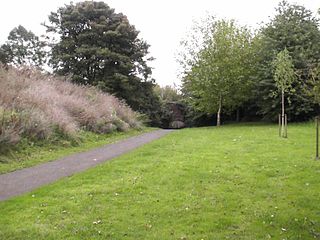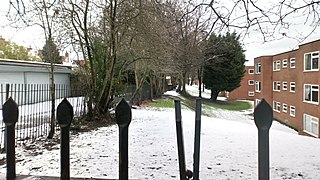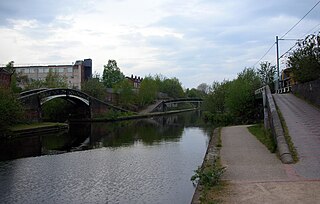
Smethwick is an industrial town in Sandwell, West Midlands, England. It lies 4 miles (6 km) west of Birmingham city centre. Historically it was in Staffordshire and then Worcestershire before being placed into then West Midlands county.

Birmingham is a major transport hub, due in part to its location in central England. The city is well connected by rail, road, and water. Public transport and key highways in the city are overseen by Transport for West Midlands (TfWM).

The Shrewsbury and Birmingham Railway was authorised in 1846. It agreed to joint construction with others of the costly Wolverhampton to Birmingham section, the so-called Stour Valley Line. This work was dominated by the hostile London and North Western Railway, which used underhand and coercive tactics. The section between Shrewsbury and Wellington was also built jointly, in this case with the Shropshire Union Railway.

Dudley Port railway station serves the Dudley Port and Great Bridge areas of Tipton, West Midlands, England. Situated on both the Stour Valley Line and Rugby–Birmingham–Stafford line, the station is operated by West Midlands Railway.

The Birmingham to Worcester via Kidderminster line is a railway line which runs from Birmingham Snow Hill to Worcester via Stourbridge and Kidderminster in the West Midlands, England. It is one of the Snow Hill Lines, with trains operated by West Midlands Trains and Chiltern Railways using a variety of rolling stock including Class 172 and Class 168 diesel units. It is a future aspiration of Network Rail to electrify the entire line, as well as the Chiltern Main Line to London Marylebone.
The Stour Valley Line is the present-day name given to the railway line between Birmingham and Wolverhampton, in England. It was authorised as the Birmingham, Wolverhampton and Stour Valley Railway in 1836; the title was often shortened to the Stour Valley Railway.
The Oxford, Worcester and Wolverhampton Railway (OW&WR) was a railway company in England. It built a line from Wolvercot Junction near Oxford to Worcester, Stourbridge, Dudley and Wolverhampton, as well as some branches.
Great Bridge North railway station was a station on the South Staffordshire Line that served the village of Great Bridge and town of Tipton in Staffordshire, England.
The South Staffordshire Railway (SSR) was authorised in 1847 to build a line from Dudley in the West Midlands of England through Walsall and Lichfield to a junction with the Midland Railway on the way to Burton upon Trent, with authorised share capital of £945,000. It was supported by the newly-formed London and North Western Railway (LNWR) and the Midland Railway, giving each company access to important areas. It completed its main line in 1849. As collieries in the Cannock region rose in importance, it built a second main line from Walsall to Rugeley, as well as numerous short spurs and connections to lines it intersected. Colliery working in the Cannock area expanded enormously, and mineral traffic carryings increased in step.
The Midland Railway branches around Walsall were built to give the Midland Railway independent access to Wolverhampton, and to a colliery district at Brownhills. The Midland Railway had a stake in the South Staffordshire Railway giving it access to Walsall, and the Walsall and Wolverhampton Railway (W&WR) was opened in 1872. At first the W&WR was independent and neutral, but it was acquired by the London and North Western Railway (LNWR), and then sold by that company to the Midland Railway.
The BCN Main Line, or Birmingham Canal Navigations Main Line is the evolving route of the Birmingham Canal between Birmingham and Wolverhampton in England.

Icknield Port Road railway station was a railway station in England, built by the Harborne Railway and operated by the London and North Western Railway in 1874.

Rotton Park Road railway station was a railway station in England, built by the Harborne Railway and operated by the London and North Western Railway in 1874.
Hagley Road railway station was a railway station in Birmingham, England, built by the Harborne Railway and operated by the London and North Western Railway in 1874. In addition to the passenger facilities, there was also a goods yard and a coal wharf.

Harborne railway station was a railway station in Birmingham, England, built by the Harborne Railway and operated by the London and North Western Railway in 1874. In addition to the passenger facilities, there was a goods shed and sidings.
The West London Railway was conceived to link the London and Birmingham Railway and the Great Western Railway with the Kensington Basin of the Kensington Canal, enabling access to and from London docks for the carriage of goods. It opened in 1844 but was not commercially successful.
The Bangor and Carnarvon Railway was a railway company promoted to build a branch railway connecting Caernarfon with the main line at Bangor, in north-west Wales. It opened in 1852 as far as Port Dinorwic and was extended to Caernarfon later in the same year.

Rotton Park is an area of Birmingham, England, encompassing the north of Edgbaston Ward and the southern extremes of Soho Ward, to the city boundary with Smethwick.
The Birmingham, Wolverhampton and Dudley Railway was an English railway company promoted to connect those places by rail. It was authorised by Parliament in 1846. It became apparent that it would be advantageous to merge with the Great Western Railway. The rival London and North Western Railway went to great lengths to frustrate the amalgamation, but ultimately failed, and the merger took place in 1847.

Summerfield is an area of Birmingham, England, two miles west of the city centre. It is also the name of an ecclesiastical parish. The area takes its name from Summerfield House, owned by members of the Chance family, local industrialists. Neighbouring areas are Cape Hill, Edgbaston, Ladywood, Rotton Park and Winson Green. Edgbaston Reservoir is immediately to the south.



















